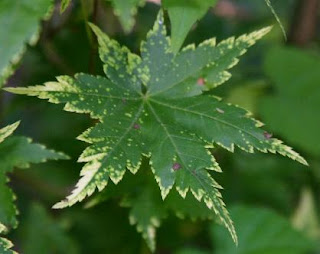A photo essay on spring, anyway. When we came home from church yesterday, these cheery yellow and brown crocuses were blooming. They weren't there when we left - such a nice surprise. You can also see the honey bee. They were all over anything that was blooming, especially the witchhazels.
 These little blue crocuses were blooming in another sunny spot. These early ones aren't especially bothered by the cold weather and will be blooming for a couple of weeks.
These little blue crocuses were blooming in another sunny spot. These early ones aren't especially bothered by the cold weather and will be blooming for a couple of weeks. This is Hamamelis (witchhazel) 'Rochester'. Always makes me think of the old Jack Benny Show when I hear that name. Not sure if it was named after that or the city. Lovely and delightfully scented nonetheless.
This is Hamamelis (witchhazel) 'Rochester'. Always makes me think of the old Jack Benny Show when I hear that name. Not sure if it was named after that or the city. Lovely and delightfully scented nonetheless.
Cardinals aren't exactly a harbinger of spring, having been here all winter, but this guy was just sitting in the sun singing and I couldn't resist snapping his picture.

The Tibetan Hellebores are now blooming. This last picture I posted had buds, but not open flowers yet. This one isn't evergreen; it goes dormant by mid-summer, but it is the first one to be up and blooming in the spring. It's also quite a bit smaller than the others we grow. I don't think it gets much over 8 inches tall.

Snowdrops (galanthus) are predictably the first things blooming here. True to their name, they will often start blooming while the snow it still on the ground. If not then, they can be in bloom withing days of the snow melt, even before the ground seems thawed enough for them to poke their noses through. This is the double version, and you could see it better if I'd been willing to crawl in the mud a bit. That will have to wait until the ground dried up a bit.

This variegated pachysandra isn't quite in blooms, but clumps of it all over the yard are now in bud. Can't be long until blossoms.

And a sure sign of spring would be that the duck weed has reappeared on the ponds, even the ones that still have some ice on them.
 And even though it's a bit colder today, I still heard the frogs on the ponds, singing their little hearts out this morning. I didn't have the heart to tell them that they'd better head back to the bottom and sleep for a bit longer. They seemed to be having such a good time.
And even though it's a bit colder today, I still heard the frogs on the ponds, singing their little hearts out this morning. I didn't have the heart to tell them that they'd better head back to the bottom and sleep for a bit longer. They seemed to be having such a good time.Jane
 Below is the second one we added, and it was even slower to establish, but now we have a couple of small colonies. It is Sasa veitchii. This is supposed to get a little taller than the plain green one, but they are the same here. The spread is also quite slow. It is good to zone 5 and is supposed to grow in sun or shade, but we have it growing under some very tall white pines and it seems quite content. New leaves that are put out in the spring are all green and stay that way through the summer. In the fall when the nights start to get crisp, the white border starts to develop and gets whiter and wider until it looks like the photo. It keeps this coloration throughout the winter. Really horrible weather may cause some 'burn' on the white edges, but it is still quite striking in the winter garden.
Below is the second one we added, and it was even slower to establish, but now we have a couple of small colonies. It is Sasa veitchii. This is supposed to get a little taller than the plain green one, but they are the same here. The spread is also quite slow. It is good to zone 5 and is supposed to grow in sun or shade, but we have it growing under some very tall white pines and it seems quite content. New leaves that are put out in the spring are all green and stay that way through the summer. In the fall when the nights start to get crisp, the white border starts to develop and gets whiter and wider until it looks like the photo. It keeps this coloration throughout the winter. Really horrible weather may cause some 'burn' on the white edges, but it is still quite striking in the winter garden.


























